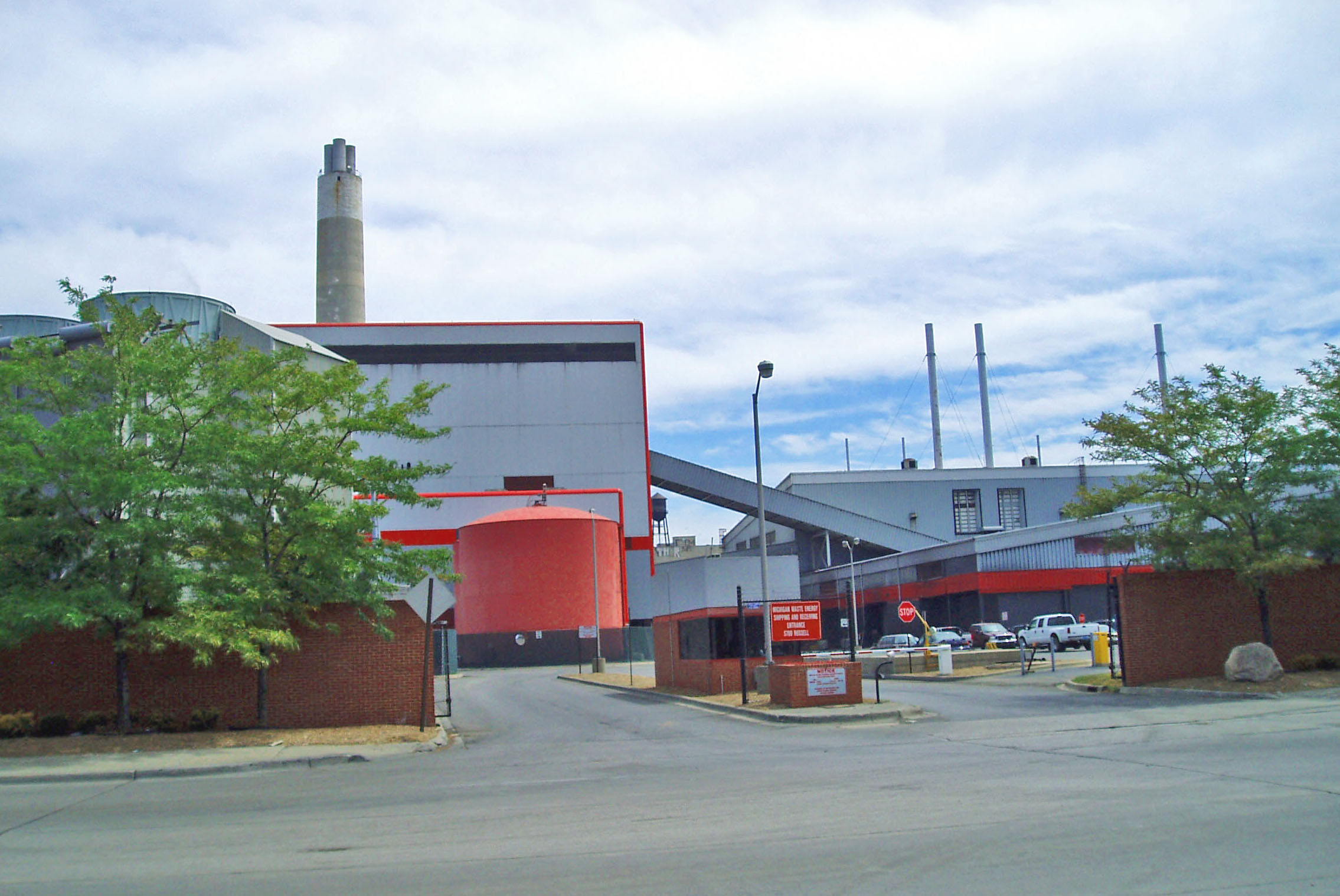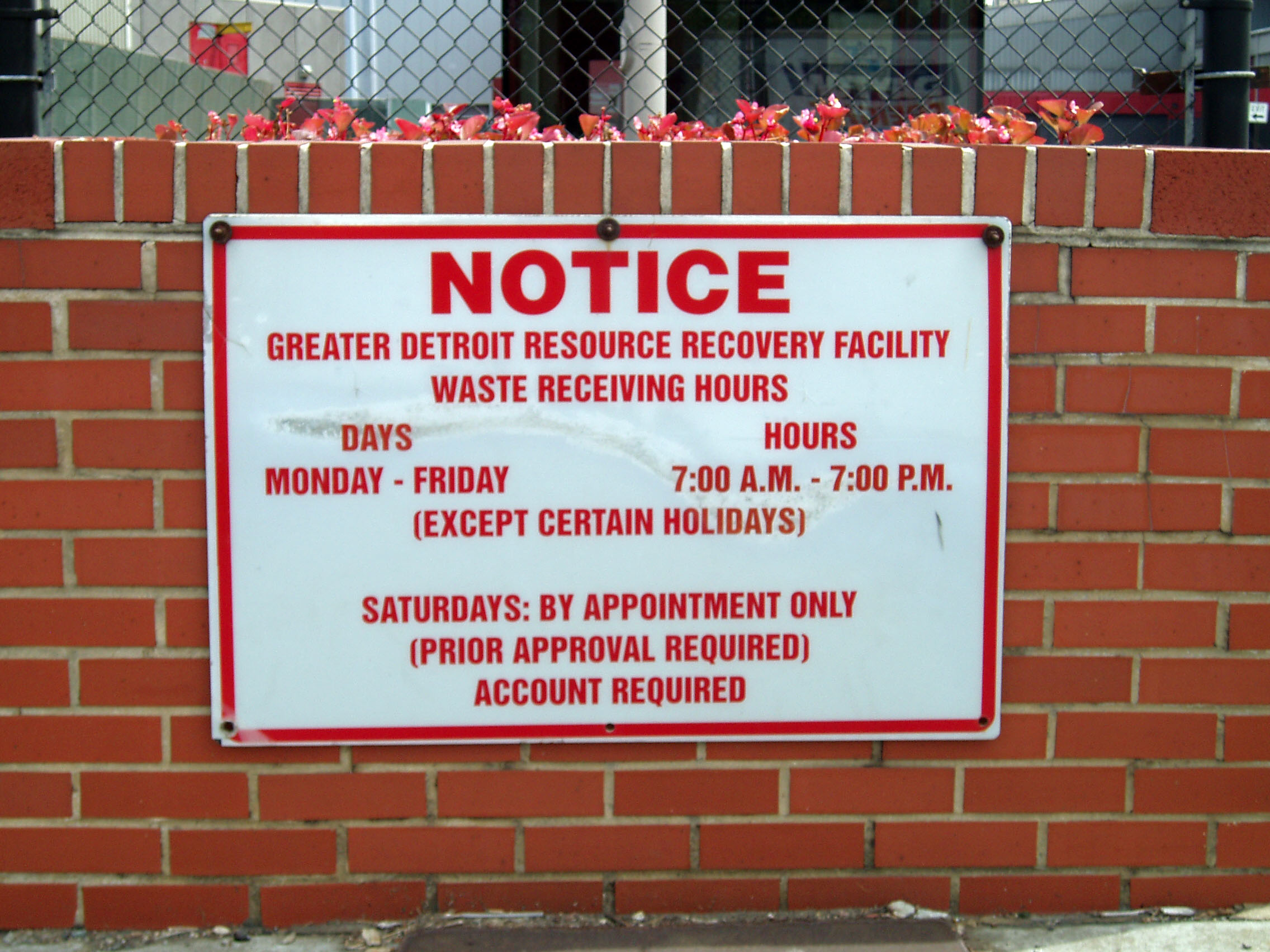

This incinerator is one of the least photographed sites in the city. Officially, the building you see is the Greater Detroit Resource Recovery Facility. Most of Detroit’s trash is burned in this facility to produce steam that generates electricity. This was—and continues to be—one of the most controversial buildings in the city.
The nation addressed a severe energy crisis during President Nixon’s administration. A new emphasis was placed on finding sources of energy other than oil or gas. At that time some engineers suggested the cities could effectively burn their trash to generate electricity that might then be sold. Rather than paying to haul waste to a land fill, a city’s garbage trucks might empty their contents into a giant incinerator that would produce electricity. For a brief period, this seemed to be an excellent solution to both the energy crisis and the challenge of getting rid of urban waste. Cities could greatly reduce the cost of getting rid of trash and generate energy at the same time.
The idea did not become very popular. Environmentalist stressed the pollution that the massive incinerators would inevitably produce, and mayors knew that it would not be easy to find neighborhoods that would accept an incinerator along with the strong odors that would accompany it since every one of the city’s garbage trucks would visit the facility once or twice a day.
It is difficult to locate a great deal of factual information about this incinerator. So far as I know, no one has written a thoughtful essay about the political, economic, environmental and racial issues involved in its construction and continued operation. Those who have written about it most frequently stress the environmental damage they link to the incinerator and go on to mention that this one of the poorest decisions made during Mayor Young’s years. The City of Detroit was extremely financially strapped in the 1970s as population and businesses moved quickly to the suburbs. The tax base was contracting rapidly but the city’s obligations and payroll remained constant or increased. I have heard—but I cannot document—that the Ford Administration promised to provide the city of Detroit with a payment of 25 to 35 million if it would build a large incinerator to demonstrate the feasibility of generating electricity from city waste. In politically correct language, the products burned in this incinerator are known as municipal solid waste—to be distinguished from municipal fluid waste. In other places, you will find that input is called refuse derived fuel. Facing immense financial difficulties, Mayor Coleman Young agreed to build the nation’s largest incinerator designed to produce electricity. I presume that he and his advisors thought this would greatly reduce the cost of waste collection services since income would be derived from the sale of steam and electricity. In the 1980s, the city issued bonds to the extent of about $440 million to build the facility you see. It is the largest municipal solid waste incinerator in the nation.
Two major difficulties had to be overcome. Health experts and environmentalists in southeast Michigan and southwestern Ontario bitterly opposed constructing this facility since, they argued, it would put millions of tons of pollutants into the air every year, pollutants that would increase morbidity rates. And then there was the choice of a Detroit neighborhood to serve as home to the incinerator. Middle- and upper-class areas, of course, had the power to block its construction. There was considerable litigation seeking to prevent the construction of this incinerator. The Province of Ontario sued since prevailing winds meant that the effluents coming from the incinerator’s smoke stacks would quickly leave the United States and reach Canada. As was typical in Detroit at this time, race regularly entered the discussion. Opponents pointed to the already elevated mortality rates of inner city blacks, especially black children and argued that the foreseeable consequence was worse health for those who lived near the facility. Many noted that the city’s children already had high asthma rates and predicted they would rise after the incinerator went into operation. To some, this indicated the Young Administration’s lack of interest in the welfare of the city’s poor citizens. After much controversy and many law suits, the Young Administration decided to build the facility in an industrial area along Russell Street. This is quite close to the racially mixed area of Detroit whose population was removed for construction of General Motor’s Poletown Plant. In addition to its odors and possible pollution, the incinerator would make the stable but rather low-income neighborhood just north of the incinerator surrounding St. Stanislaus Church even less attractive.
The Detroit Incinerator opened in 1986 but the controversy did not abate. Once it was in operation, its opponents attempted to produce factual information about increases in pollutants in the neighborhoods in Detroit and Windsor coming from the plant. In 1991, the State of Michigan’s Department of Environment Quality more or less accepted the arguments of the critics and ruled that if the incinerator were to have its operations permit renewed, expensive new pollution control had to be added. The City of Detroit lacked funds to install this equipment. Perhaps, the Young Administration could have shut the expensive plant they just completed. Instead, they decided to sell the incinerator to financial holding companies, the lead one affiliated with Phillip Morris tobacco and the other was a firm called Aviation Services. Those companies paid the city $54 million in cash for the facility and issued bonds for the $157 million needed for new equipment, bonds that the city is still paying. In addition, the firms received pollution tax credits worth about $200 million. The City of Detroit agreed to continue paying the firm for use of the plant through 2009.
The incinerator is currently operated by the Michigan Waste Energy firm which is a subsidiary of Covanta Energy. This large New Jersey firm specializes in producing energy from waste, that is, they are a refuse derived fuel firm. The Detroit incinerator was designed with three large furnaces capable of burning 4,000 tons of trash every day. Environmental restrictions now permit the operation of only two furnaces simultaneously so about 2,800 tons are burned daily. Trucks dump the city’s solid waste at the incinerator. It goes on to a conveyor belt and metal objects are sucked out. The solid waste is then shredded and pulverized for burning in a furnace at a temperature of 2,300 degrees. Pipes conveying water through the furnace generate steam that is then used to propel a turbine that produces electricity. The facility generates both steam and electricity that are sold to Michigan Consolidated Gas/Detroit Edison for as much as $40 million annually. In addition to Detroit’s solid waste, I believe that the facility burns solid waste generated by firms and other clients in the area.
It is difficult to obtain accurate information about the financial history of the facility or its current financial operation. Opponents continue to stress that, despite the new equipment, the Detroit incinerator is one of the state’s leading sources of pollutants. Even though it meets current requirements, it turns out 25 tons of hazardous air pollutants annually plus 1800 tons of other pollutants including sulfur dioxide, nitrous oxide, mercury and lead. However, critics of the plant almost always link their comments to the observation that the city of Detroit is now paying very much more per ton to get rid of their solid wastes than are surrounding communities or other large cities. The cost of putting municipal solid waste into landfills in Michigan has not escalated recently; indeed, the state’s landfills may have excess capacity. But the city of Detroit is obligated to pay Covanta Energy to burn its trash in the incinerator on Russell Street. These critics claim that Detroit is paying as much as $125 per ton to get rid of municipal solid waste that might be put into local landfills at a cost of around $25 per tone. This comparison may be misleading since, I believe, the $125 per ton cost includes servicing the bonds used to construct and update the incinerator. Whether or not the incinerator is used, the city will have to pay those bonds to maintain a satisfactory credit rating. Detroit is distinguished from almost all other major cities in the United States by the absence of recycling activities. This is explained by the city’s commitment to the incinerator you see pictured above. Critics also speculate that solid waste gathered in the city’s miniscule recycling program end up in the incinerator.
Many of those who criticize the Detroit incinerator present strong but rather one-sided arguments. The idea of burning municipal solid waste spread a bit in the United States and, at one point, as many as 119 incinerators similar to the one in Detroit were operating. Indeed, a group of western Wayne Counties now burn their solid wastes in a Dearborn Heights incinerator to generate energy and one in Hamtramck specializes in burning hospital waste. To be sure, the owners and operators of these incinerators seek to minimize information about them. They certainly don’t give tours or get their locations listed on maps. Perhaps as much as 14 percent of the nation’s solid waste is now burned in the 89 waste-to-energy incinerators operating in the country in 2007 and they produce about three one-thousands on the nation’s electricity. Most who oppose the incinerators fail to consider the pollution that would be generated by burning coal or oil. Incinerating solid waste is somewhat more commonly done in northern Europe and Japan. In those places, this process is known as the Waste To Energy technology.
President Bush’s 2006 call for energy independence led to additional debate about the feasibility of burning more refuse to generate energy in this nation. Its defenders stress that it may do less damage to the environment than many other sources of producing energy. Nevertheless, the Environmental Protection Agency’s website carefully explains in detail that, even after using modern scrubbing equipment, burning municipal solid waste produces nitrogen oxides, sulfur dioxides and trace amount of mercury and dioxins along with the primary greenhouse gas, carbon dioxide. However, the carbon dioxide derived from burning municipal solid waste may be less adverse to the environment than the carbon dioxide that comes from burning fossil fuels. Defenders of the Waste-to-Energy strategy point out that modern equipment can remove almost all of the dangerous by-products of burning trash and emphasize that current regulations mean there are no health risks involved in these incinerators.
I believe that the Detroit’s contract to use the incinerator pictured above comes to an end in 2009. By that time, the city will have paid off the bonds so the cost of using the incinerator should decline precipitously. Burning garbage is not yet an acceptable idea. I suspect that immense pressure will be put on City Council to cease using the facility in 2009 even if it is an economically feasible and safe approach to getting rid of municipal solid waste.

Architect or designer: Unknown to me
Date of construction: 1986 to 1989
Architectural style: Modern energy generation plant
Use in 2007: This plant generates steam and electricity which is sold to
Detroit Edison by burning solid waste.
Operators in 2007: Greater Detroit Recovery Authority and the Coventa
Michigan Waste Energy subsidiary of Conventa Energy.
Website for operator: http://www.covantaholding.com/site/locations/covanta-michigan.html
City of Detroit Designated Historic District: Not listed
State of Michigan Registry of Historic Sites: Not listed
National Registry of Historic Places: Not listed
Photograph: Ren Farley; July 23, 2007